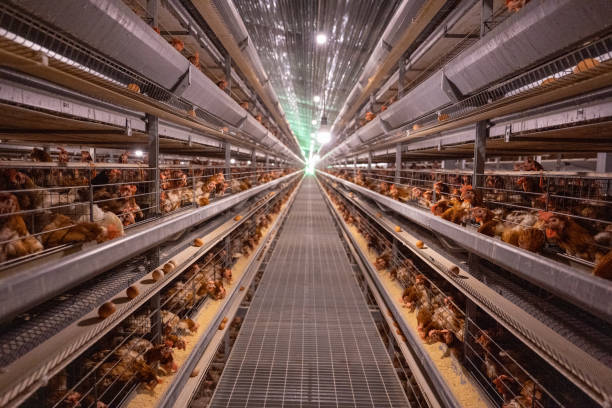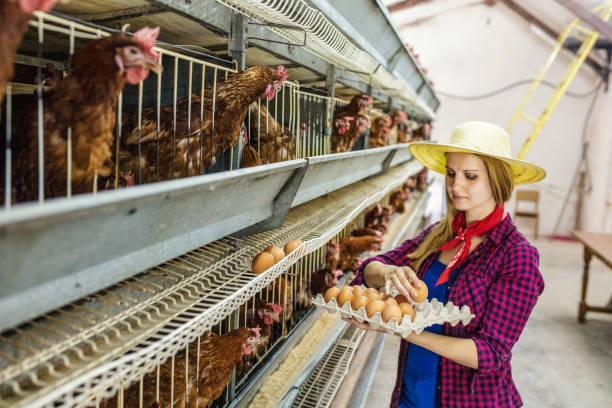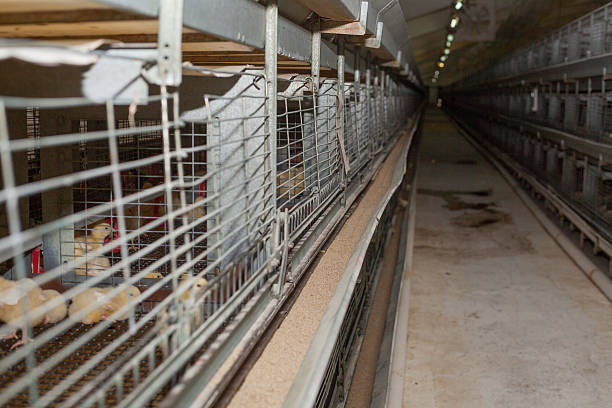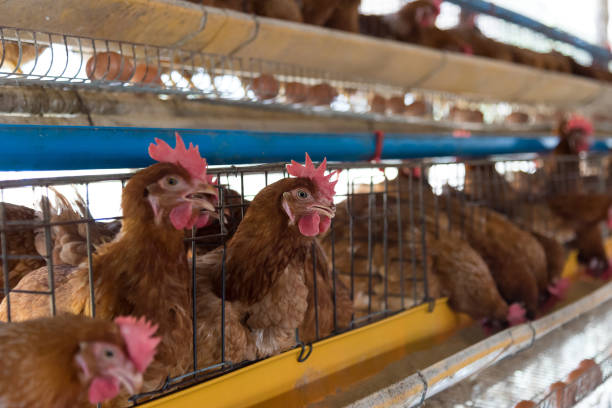Maximizing Production: 10000-Layer Battery Cages for Nigerian Poultry Farms
Maximizing Production: 10000-Layer Battery Cages for Nigerian Poultry Farms
The Nigerian poultry industry is booming, driven by increased demand for eggs and chicken meat. For poultry farmers looking to scale up their operations and maximize egg production, investing in efficient housing systems is paramount. Battery cages, particularly those designed for 10,000 layers, offer a compelling solution. These systems optimize space, improve hygiene, and streamline management, ultimately leading to higher yields and profitability. This article delves into the advantages of using 10,000-layer battery cages in Nigerian poultry farms and provides essential considerations for implementation.
Understanding Battery Cage Systems
Battery cages are a form of housing system commonly used in poultry farming for laying hens. They consist of rows of tiered cages arranged in a systematic manner, typically made of galvanized wire mesh. Each cage houses a small group of hens, providing them with access to feed, water, and an egg-laying area. The design facilitates easy egg collection, waste removal, and overall management of the flock.
Why Choose 10,000-Layer Battery Cages?
For large-scale poultry farms in Nigeria, 10,000-layer battery cages offer numerous advantages:
Increased Production Capacity: The primary benefit is the sheer scale of production. Housing 10,000 hens in a controlled environment allows for a substantial increase in egg output compared to smaller or less efficient systems. This is critical for meeting the growing demand for eggs in the Nigerian market.
Optimized Space Utilization: Battery cages maximize space utilization by housing a large number of birds in a compact area. This is especially important where land is limited or expensive, allowing farmers to achieve higher stocking densities.
Improved Hygiene and Disease Control: The design of battery cages facilitates better hygiene. The wire mesh floors allow droppings to fall through, reducing the hens’ contact with their waste. This minimizes the risk of disease outbreaks and improves the overall health of the flock.
Efficient Management: Battery cages streamline many aspects of poultry management. Automatic feeding, watering, and egg collection systems reduce labor requirements and improve efficiency. This allows farmers to focus on other critical tasks, such as monitoring flock health and optimizing feed rations.
Precise Environmental Control: In larger battery cage systems, environmental control becomes more manageable. Ventilation, temperature, and lighting can be precisely controlled to create optimal conditions for egg production. This is particularly important in Nigeria’s hot and humid climate.

Reduced Egg Breakage: Battery cages are designed to gently roll eggs away from the hens after laying, minimizing the risk of breakage. This leads to higher egg yields and reduced losses.
Better Monitoring and Control: With a concentrated flock, it becomes easier to monitor individual hen performance. Farmers can readily identify and address any health issues or variations in egg production, allowing for timely intervention and improved overall flock management.
Key Considerations Before Implementation
While 10,000-layer battery cages offer significant advantages, successful implementation requires careful planning and consideration of the following factors:
Space Requirements: Despite optimizing space, a 10,000-layer system still requires a substantial building or structure. Proper planning is essential to ensure adequate space for the cages, walkways, ventilation equipment, and other necessary facilities. Generally, a floor area of about 1000 square meters is required.
Cage Selection: The type and quality of cages are crucial. Choose cages made from durable, corrosion-resistant materials. Consider features such as automatic feeding and watering systems, egg collection mechanisms, and manure removal systems. Ensure that the cage design provides adequate space and comfort for the hens.
Ventilation System: Proper ventilation is essential for maintaining air quality, regulatingTemperature, and removing excess moisture. A well-designed ventilation system will prevent the buildup of ammonia and other harmful gases, reducing the risk of respiratory problems and improving hen health.
Feeding and Watering Systems: Automatic feeding and watering systems are highly recommended for large-scale battery cage systems. These systems ensure that hens have continuous access to feed and water, promoting optimal growth and egg production.
Manure Management: Efficient manure management is crucial for maintaining hygiene and preventing environmental pollution. Consider installing a manure removal system that will regularly remove waste from the cages. This will reduce the risk of disease outbreaks and improve the overall cleanliness of the farm.
Lighting System: A well-designed lighting system is essential for stimulating egg production. Provide adequate lighting during the laying period and ensure that the lighting schedule is consistent.
Biosecurity Measures: Implementing strict biosecurity measures is critical for preventing disease outbreaks. Control access to the farm, require visitors to disinfect their shoes and hands, and maintain a clean and sanitary environment.
Water Source: Ensure a reliable and clean water source. Laying hens need a constant supply of fresh water for optimal egg production. Water quality should be regularly tested.

Power Supply: A reliable power supply is essential for operating automatic feeding, watering, ventilation, and lighting systems. Consider investing in a backup generator to ensure continuous operation during power outages.
Egg Collection System: Choose an efficient egg collection system that minimizes egg breakage and reduces labor requirements. Automatic egg collection systems can significantly improve efficiency.
Waste Disposal: Plan for proper disposal of poultry waste. Composting, anaerobic digestion, and other methods can be used to treat and dispose of manure in an environmentally friendly manner.
Investment Costs: Battery cage systems require a significant upfront investment. Consider the costs of cages, buildings, equipment, and installation. Develop a comprehensive business plan that outlines your expected costs, revenues, and profits.
Regulatory Compliance: Ensure compliance with all relevant regulations and standards related to poultry farming. This includes obtaining necessary permits and licenses, adhering to animal welfare standards, and following environmental regulations.
Labor Requirements: While automation reduces labor, you’ll still need staff for monitoring, maintenance, and management. Evaluate your labor needs and factor this into your operational costs.
Hen Welfare Considerations: Even with battery cages, prioritize hen welfare. Ensure adequate space, proper ventilation, and access to food and water. Regular health checks are crucial.
Staff Training: Provide adequate training to your staff on proper operation and maintenance of the battery cage system. This will ensure that the system is used correctly and that potential problems are identified and addressed promptly.
Choosing the Right Battery Cage System Supplier
Selecting a reputable and experienced supplier is paramount for success. Consider the following factors:
Experience and Reputation: Choose a supplier with a proven track record in the poultry industry. Look for a supplier that has experience installing battery cage systems in similar climates and environments.

Quality of Materials: Ensure that the cages are made from high-quality, durable materials. The cages should be resistant to corrosion and easy to clean.
Customization Options: Look for a supplier that offers customization options to meet your specific needs. The cages should be adaptable to your building layout and management practices.
Technical Support and Training: Choose a supplier that provides comprehensive technical support and training. The supplier should be able to assist you with installation, maintenance, and troubleshooting.
Warranty and Service: Ensure that the supplier offers a warranty on their products and provides reliable after-sales service.
Price and Value: Compare prices from multiple suppliers, but don’t solely base your decision on price. Consider the overall value of the system, including quality, features, support, and warranty.
Management Practices for Maximizing Egg Production
Even with the best battery cage system, proper management practices are crucial for maximizing egg production.
Feed Quality: Provide a high-quality feed that meets the nutritional needs of laying hens. Work with a nutritionist to develop a balanced feed formulation that promotes optimal egg production. Regularly monitor feed quality and adjust the formulation as needed.
Water Quality: Provide a continuous supply of clean, fresh water. Regularly test water quality and treat any contamination.
Lighting Program: Implement a consistent lighting program to stimulate egg production. Provide adequate light intensity and duration during the laying period.
Disease Prevention: Implement strict biosecurity measures to prevent disease outbreaks. Regularly monitor the health of the flock and take prompt action to address any health issues.
Vaccination Program: Implement a comprehensive vaccination program to protect against common poultry diseases.
Parasite Control: Regularly monitor for parasites and implement a control program as needed.
Environmental Control: Maintain optimal environmental conditions within the poultry house. Regulate temperature, humidity, and ventilation to ensure the comfort and well-being of the hens.
Record Keeping: Keep accurate records of egg production, feed consumption, mortality, and other relevant data. This information will help you identify trends and make informed management decisions.
Culling: Regularly cull unproductive hens from the flock. This will improve overall efficiency and reduce feed costs.
The Future of Battery Cages in Nigeria
While battery cages remain a popular choice for large-scale egg production in Nigeria, there’s growing interest in alternative housing systems, such as enriched cages and free-range systems. These systems offer improved welfare for hens, but they also come with higher costs and management challenges.
The future of battery cages in Nigeria will likely depend on a combination of factors, including consumer demand, regulatory changes, and technological advancements. Farmers will need to carefully weigh the costs and benefits of different housing systems to determine the best option for their specific circumstances. As consumers become more aware of animal welfare issues, there may be increased pressure on farmers to adopt more humane housing practices.
Conclusion
Investing in a 10,000-layer battery cage system can be a strategic move for Nigerian poultry farmers seeking to maximize egg production and profitability. By carefully considering the factors outlined in this article, farmers can make informed decisions about system selection, implementation, and management, ultimately contributing to the growth and sustainability of the Nigerian poultry industry. While it’s crucial to consider the ethical implications and strive to improve hen welfare within these systems, the efficiency and productivity gains they offer cannot be ignored in the face of increasing demand for affordable eggs. The long-term success depends on striking a balance between production efficiency, animal welfare, and environmental sustainability.





